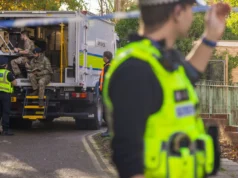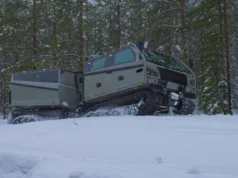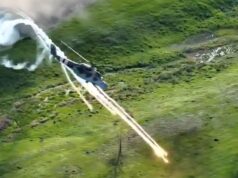The Minerva Team, led by Leonardo UK in collaboration with Dstl and QinetiQ, is advancing the development of the Modular Integrated Protection System (MIPS) programme for the British Army.
The initiative is set to enhance the protection capabilities of the Army’s fleet, encompassing tanks and armoured personnel carriers, against a spectrum of threats, both current and emergent.
Richard Muir, Vice President of Sales Integrated Sensing and Protection at Leonardo UK, expressed enthusiasm about the project’s progression, stating, “We are excited to be working with Dstl and QinetiQ in leading the Minerva Team on this latest phase of the UK Modular Integrated Protection System programme. MIPS will be a life-saving technology that will also provide the UK with operational independence for a critical British Army capability.”
Echoing this sentiment, Jamie MacKenzie, Head of Business Development for UK Defence at QinetiQ, remarked, “QinetiQ is delighted that Dstl has selected the Engineering Delivery Partnership for this critical next phase of research. Specifically, phase II of the MIPS programme will demonstrate a significant advancement in the future-proofing of capability for the British Army in this critical area of protection systems.”
The project, dubbed Team Minerva, is tasked with advancing the UK systems architecture standard, allowing for the configuration of Active Protection Systems (APS) across various armoured vehicle types.
This will involve addressing a broad spectrum of threats, including Rocket Propelled Grenades (RPGs), Anti-Tank Guided Weapons (ATGWs), and Small Uncrewed Aerial Systems (UAS).














There are already a number of systems out there. I know for a fact that Rhienmetall have a system that is capable of being fitted to the RMMV vehicle fleet.
As a question to everybody, does anybody else have very little faith in the powers that be who run the MOD?
So regards MIPS, the MOD have been funding research into this very field for over 8 years and they are still f-ing talking about it. FFS
2016: July 2016, the UK’s Defence Science and Technology Laboratory placed a £7.6 million contract with QinetiQ to evaluate the MUSS system for armoured vehicles, particularly the Challenger 2 main battle tank
2017: Under the British £10 million Icarus technology demonstration program, the company will focus on the implementation of a ‘UK Sovereign’ electronic architecture for a Modular, Integrated Protection System (MIPS) that will enable MOD to pick and choose specific APS solutions for evolving threats and operational requirements. In the ICARUS program, MOD is taking a similar approach to the Generic Vehicle Architecture (GVA) that defines the electronic standards for military vehicles.
2018: The UK Ministry of Defence (MoD) now knows its requirements regarding Active Protection Systems (APS) for tactical ground vehicles. Addressing delegates at the Future Armoured Vehicles Survivability conference in London on 13 November, Colonel Nick Cowey, assistant head of Ground Manoeuvre for Combat Capabilities, British Army, described ground force perspectives for APS technology to support current and future operations.
2019: Dstl and QinetiQ say they have completed trials to assess a system to protect combat vehicles and their occupants. The organisations say that October 2019 marked the completion of the Medusa Technology Assessment Programme (TAP), which has been running for the last 3.5 years.
2020: Leonardo UK has confirmed that in November 2020 it will complete, on schedule, the contract for the ICARUS Technology Demonstrator Programme (TDP) which in the longer term will enable the British Army to field agile automatic Active Protection Systems (APS) on its current and future armoured fighting vehicle (AFV) platforms to enhance their survivability against a wide range of battlefield threats. Following completion of a competitive selection process, in June 2017, the UK Defence Science and Technology Laboratory (DSTL) awarded the ICARUS TDP to Leonardo UK with a value of £10M. The ICARUS TDP forms a pillar of the UK DSTL Active Integrated Protection Systems (AIPS) strategy.
2021: Trophy MV from Rafael will undergo detailed integration and system trials on Challenger 3.Rafael Advanced Defense Systems announced on 24 June that a lightweight version of its Trophy Active Protection System (APS) for armoured vehicles has been selected by the UK MoD for the next phase of detailed assessment and integration with the upgraded Challenger 3 main battle tank.
2022: A £15 million boost funded by the British Army over the next three years will enable the latest development phase of its cutting-edge anti-missile system which aims to keep soldiers safer inside armoured vehicles. The automated Modular Integrated Protection System (MIPS) classifies incoming enemy missiles, intercepts and destroys them. To do this, the ‘brain’ identifies what the incoming threat is and decides how best to defeat the object at precisely the right moment all in superfast time. Minister for Defence Procurement, Alec Shelbrooke said: “Our Armed Forces keep us safe around the clock and it’s incumbent upon us to do all we can to protect them and adapt to future threats.
2023: RAFAEL, a world leader in advanced defense technologies, is pleased to announce the successful acquisition of a £20 million contract from the UK Ministry of Defence (MOD) for the state-of-the-art TROPHY Active Protection System (APS). This significant milestone represents a major advancement in bolstering the defensive capabilities of the Challenger 3 Main Battle Tanks (MBTs) and underscores RAFAEL’s active participation in DSEI 2023.
Talk about dragging things out
It’s just an excuse to cover a passing of tax payers money to whichever industry fat cat has garnered favour with our government. There is no intent for it to ever actually lead to a worthwhile end product. Corruption hiding in plain sight
Sadly that does seem to be the priority in a whole range of contracts and programmes. I guess it mirrors similar priorities in politicians personal career development so comes naturally to them once in positions of power. Explains why so much investment ends up in so little end product so often.
Sadly, I have decided that this is true. The priority is the fat cats in industry. The sooner this is highlighted, the better.
Also, has anybody seen the prototype? I can only find a vague image from 1.5 years ago on UKDJ and the same image is on the army website of the system.
These things take time, Trophy development began in the early 1990s and was only ready for fielding in 2011.
Louis,
Trophy was ready to be deployed early 00s, but the cost put the Israeli Government off, and then in 2006, Lebanon happened and that soon changed everybody’s mind and it was given the go ahead for production and deployment with the first active system on line in 2010. Interestingly it was Iron fist which was the front runner, but the IDF went with Trophy. (Iron fist has the ability to take out tank projectiles and can be fitted without cutting into the tank, however it is limited to 2 rounds , Trophy has 3) But the point is taken regards development time, that said when the Uk started researching APS , despite Trophy already been battle proven, the UK decided to go down the route of soft kill rather than hard kill and only recently changed its mind to hard kill i quote from RUSI in 2017:
Reconciling Active Protection Systems with the SDSRThe Ministry of Defence recently allocated £7.6 million to a ‘soft kill’ active protection system for armoured vehicles, being tested by QinetiQ. This article examines the potential place of such capabilities within the armoured concepts outlined in the 2015 Strategic Defence and Security Review.
2006 should have been a wake up call for all armies…Isreal a well trained well equipped modern military had 54 damaged MBTs with 20 complete losses over 1 months fighting against what was essentially an irregular force….they developed active protection and the next time they had the same type of conflict against the same type of enemy ( Hamas in Gaza the next time two years later ) but with active protection systems they lost no MBTs..and shot down a lot of anti tank missiles…..the fact the British army, MOD and HMG in General ignored this is a bit shite.
But sadly predictable, too often in Britain (other places no doubt too) the Raison d’être of any programme becomes prioritised around the participants and their connections, or indirect industrial considerations rather than the quality, timeliness and usefulness of the actual system which complacency convinces will never be tested in real combat no doubt fuelled by the end of the Cold War and presumption that only low level conflicts against non peer adversaries were at all likely. Similar scenarios occurred in the late 30s when we were churning out 100s of Fairey Battles even when we realised they weren’t what we needed simply because in desperation it was the easiest way to gain airframe numbers but Treaty restrictions had left us limited as to what we could actually at the time produce even though those restrictions had already been deemed strategically irrelevant. Under present pressures I hope we don’t go down similar paths.
Indeed, but with the lesson around MBTs it was clear..even a none peer enemy irregular force, if equipped by state actors out to get you and in the right setting could shred your MBT force if it did not have an active protection system….from 2010 onward, every western MBT force should have had active protection systems…it’s not like the IDF were tactically incompetent or had bad MBTs….in 2006 and suddenly changes in 2008 the only different was the active protection system….even the end of history idiots should have got that message.
Probably the same reason that suddenly Royal Navy after decades of despising naval guns when BAE bought Bofors and the 5″ US industry then suddenly an UK frigate have 3 guns in prominence..
Can’t help thinking that we did this R&D and evaluation better (quicker and cheaper) in the days of RARDE.
Spot on there Graham. Back then RARDE and other such organisations were given money to try stuff out. No shareholders to satisfy, no massive bonus incentives for individual members of the organisation etc.
I spent 5 years at Chertsey before I left the Army and used to see some really weird and wonderful stuff as I wandered around site.
I was an SO2 for 2 years at RARDE Chertsey in 1990-91 in the division responsible for Unmanned Vehicles and Robotics – the work we were doing was 15 years ahead of civvy R&D and we had a smaller budget and fewer staff than a civvy company would.
Many innovations and innovative design (too many to mention) can be traced back to RARDE work – be it vehs at Chertsey, weapons at Fort Halstead, Sigs and Radar at Malvern or Sapper kit at Christchurch. Testing of new-to-service kit was superbly well done too, quick, effective and at low cost to MoD. Our test track at Chertsey was so good it was hired by commercial companies and the Top Gear team regularly, and our off-road circuit was used by factory rally teams to test new cars.
Ease of Maintenance Assessments on new kit by REME specialist units used the full array of RARDE facilities – and were very well done.
Staff were permitted to work on pet projects that they had a passion for even if MoD had not formally endorsed the work. Initiative can be a great thing.
So what happened?
What happened to RARDE? It was sharpened up, pet projects were banned, some expensive-to-run facilties were decommissioned, Design Authority status was lost to the OEM and it became DERA then DRA (or vice versa). Still HMG owned and operated.
Then it was split into dstl and QinetiQ – the former being small and HMG owned…and the latter being commercially run.
The Chertsey site where I was was sold by MoD and became a film studio – Longcross Studios.
Tragic mate, BLOODY TRAGIC.
Blair sold off DERA I recall. At least we retained the most sensitive bits through DSTL. Not in your field though.
It was very strong US pressure that made us create in-house dstl – otherwise the whole of DERA would have been rebranded as commercial QinetiQ.
I guess that having the technology developed makes production much easier if it’s needed quickly.
Just now the funds for production probably aren’t available unfortunately.
Everything is so expensive for defence related kit so somethings need to be on the back burner.
Got to wonder if making new vehicles with this tech incorporated and selling/gifting the used vehicles would be a better idea than upgrading 20-50 year old vehicles. Imagine trying to upgrade a 30 year old Vauxhall Astra compared with getting a new one.
I would expect the Army/MoD to have done a serious rethink of not only the requirement for APS following the experiences of the ongoing Ukraine War, but also the threat!
It showed that when the Ukrainian War kicked off, both Javelin and NLAW were near enough unstoppable. Even against the latest Russian jammers and countermeasures. Following the near absence of Russian SHORAD amongst the front lines. Drones like the TB2, dropping unpowered guided bombs easily targeted the Russian tanks upper deck and top of the turret. Leading Russian tanks to be fitted with hastily designed cope cages. Following on from Russia finally sorting out their air defence layers, saw the demise of the TB2. But the rise of the loitering munition and First Person View (FPV) suicide drone. Where both of these were again targeting the thinner top armour of tanks.
In a separate conflict between Hamas and Israel, we saw the first losses of the Merkava 4 fitted with Trophy APS. Previously with Trophy fitted, the APS has successfully defended the tank against all anti-tank guided weapons (ATGWs). However, through trial and error, Hamas clearly worked out that Trophy has a finite effective range. Which saw them flying their bomb carrying drones above Trophy’s effective range. Then dropping their weapon’s directly on top of the turret. Which was beyond the effective elevation angle for the Trophy’s turrets.
Clearly Trophy works against traditional anti-tank guided missiles (ATGMs) and RPGs. Not so much against direct top attack from overflying drones, that drop their weapon’s in Trophy’s blind spot. It’s without doubt that the Israeli Army will require Trophy to be upgraded to deal with this new threat. Thereby our vehicles will also get the upgrade.
The APS needs to fill in the blind spot above the vehicle and be capable of dealing with the threat with a better stand-off range! So a number of things come to mind. Firstly add a 5th X-band radar to the turret roof, that points directly up. Which will allow the system to not only search for the threats but also constantly track them, giving the vehicle a full hemispherical coverage. Secondly increase the effective elevation angle of the two effector turrets. Thirdly, link the vehicle’s remote weapon system (RWS) to the APS radar and control system. Even if the RWS’s weapon is a MG, it will have an effective range of at least 1km. But be capable of knocking out from a distance, a bomb carrying drone, FPV drone and possible a more expensive loitering drone. The fourth option is changing the effector from the Trophy’s directed tungsten fragments to an Iron-Fist like concussion effector. Which means it will have a better chance of not only damaging a fuze in a vertical falling mortar shell. But also be capable of deflecting its path away from the vehicle.
And after millions upon millions spent nothing will come remotely close to service.
Wouldn’t do to just buy something that works though…
I said this before, and I’ll say it again from just under 1.5 years ago. “And there’s me thinking that Project Icarus had flown too close to the sun.”
It’s that force field picture again….warp speed mr Scottie and raise the shields Chekhov.
Another money burning exercise that will (possibly) produce a product that already exists but at a higher cost.
Well that’s my confusion here, all the talk of sovereign capability but in the end we are effectively buying a long existing product but concealed within a whole range of UK project names that add what precisely? Opportunity to hide added benefits to interested parties under the guise of supposed added capability? Is the veneer of great British ‘invention’ and innovation simply there to fool the public that great British achievements are being made here for the sake of National pride under the guise of ‘World leading’ monikers they so love?
Some of it is the needed. Cultural difference etc need someone that talks same language so to speak, some is testing to adapt, but as you say it fast can be a an exercise in takin a cut adding a small benefit that do not justifies the cost.
I think the Russian version uses two tennis rackets and a butterfly net.
So, implement something Russians started using 50 years ago?
Bravo on the timely implementation.
Well we see how good Russian stuff is in Ukraine. Not very good. I will need to look but can’t think I’ve seen an active protection system actually working as intended on the battlefield videos.
Well the Drozd system was nothing like these..it was an active protection that used a radar trigger to basically set of a load of claymore mines..that had the unfortunate side effect of killing all the troops the tank was supporting…it was also rubbish..in the end it was only ever fitted to 250 t55s before being withdrawn. They development the arena system as a concept in the late 1990s but it never went into production……they are now looking at actually producing Arena M…the only people to have actually seriously equipped its armoured force was Israel..the U.S. have only just taken it up..everyone is late apart from Israel.
Thank god for that.
Finally!!!!
About bloody time too!!!!
I can only applaud this massively overdue programme to prepare our armoured fleet for APS fitting.
£450 million well spent as long as it’s followed up by an APS system fit.
Don’t want any more FFBNW fiascos